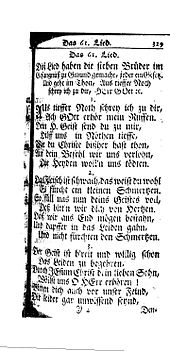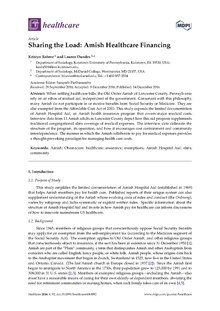Amish
[2] As they maintain a degree of separation from surrounding populations, and hold their faith in common, the Amish have been described by certain scholars as an ethnoreligious group, combining features of an ethnicity and a Christian denomination.The Amish church began with a schism in Switzerland within a group of Swiss and Alsatian Mennonite Anabaptists in 1693 led by Jakob Ammann.The Ordnung must be observed by every member and covers many aspects of Old Order Amish day-to-day living, including prohibitions or limitations on the use of power-line electricity, telephones, and automobiles, as well as regulations on clothing.[citation needed] Swiss Anabaptism developed, from this point, in two parallel streams, most clearly marked by disagreement over the preferred treatment of "fallen" believers.Between 1717 and 1750, approximately 500 Amish migrated to North America, mainly to the region that became Berks County, Pennsylvania, but later moved, motivated by land issues and by security concerns tied to the French and Indian War.Between 1862 and 1878, yearly Dienerversammlungen (ministerial conferences) were held at different places, concerning how the Amish should deal with the tensions caused by the pressures of modern society.The Amish's willingness to submit to the "Will of Jesus", expressed through group norms, is at odds with the individualism so central to the wider American culture.The Ordnung must be observed by every member and covers many aspects of day-to-day living, including prohibitions or limitations on the use of power-line electricity, telephones, and automobiles, as well as regulations on clothing.The Amish value rural life, manual labor, humility, and Gelassenheit, all under the auspices of living what they interpret to be God's word.Prayer kapps and bonnets are worn by the women because they are a visual representation of their religious beliefs and promote unity through the tradition of every woman wearing one.The color coding of bonnets is important because women are not allowed to wear jewelry, such as wedding rings, as it is seen as drawing attention to the body which can induce pride in the individual.[61][page needed] The Old Order Amish seldom, if ever, use buttons because they are seen as too flashy; instead, they use the hook and eye approach to fashion clothing or metal snaps.Food plays an important part in Amish social life and is served at potlucks, weddings, fundraisers, farewells, and other events.[62][63][64][65] Many Amish foods are sold at markets, including pies, preserves, bread mixes, pickled produce, desserts, and canned goods.[75][76][77][78] Ultimately, the terms Deitsch, Dutch, Diets and Deutsch are all cognates and descend from the Proto-Germanic word *þiudiskaz meaning "popular" or "of the people".[citation needed] Several other groups, called "para-Amish" by G. C. Waldrep and others, share many characteristics with the Amish, such as horse and buggy transportation, plain dress, and the preservation of the German language.[citation needed] In 2016, several dozen Old Order Amish families founded two new settlements in Kings County in the province of Prince Edward Island.[1] The first attempt by Old Order Amish to settle in Latin America was in Paradise Valley, near Galeana, Nuevo León, Mexico, but the settlement lasted from only 1923 to 1929.[111] In 2015, new settlements of New Order Amish were founded east of Catamarca, Argentina, and Colonia Naranjita, Bolivia, about 75 miles (121 km) southwest of Santa Cruz.[citation needed] More people have tested Old Order Amish life for weeks, months, or even years, but in the end decided not to join.[116] On the other hand, the Beachy Amish, many of whom conduct their services in English and allow for a limited range of modern conveniences, regularly receive seekers into their churches as visitors, and eventually, as members.[123] Amish populations have higher incidences of particular conditions, including dwarfism,[124] Angelman syndrome,[125] and various metabolic disorders,[126] as well as an unusual distribution of blood types.[citation needed] While the Amish are at an increased risk for some genetic disorders, researchers have found their tendency for clean living can lead to better health.The clinic is embraced by most Amish, ending the need for parents to leave the community to receive proper care for their children, an action that might result in shunning.As they go without health insurance and pay up front for services, Amish individuals will often travel to Mexico for non-urgent care and surgery to reduce costs.This exemption applies to a religious group that is conscientiously opposed to accepting benefits of any private or public insurance, provides a reasonable level of living for its dependent members, and has existed continuously since December 31, 1950.Also, a number of private enterprises publish everything from general reading to reprints of older literature that has been considered of great value to Amish families.[156] Reports of poor standards of care and treatment of dogs as a cash crop by members of the Amish community has led to calls for puppy mills and auctions to be closed, with one breeder being issued with a restraining order from the practice for numerous violations of the federal Animal Welfare Act.[157] Anabaptist groups that sprang from the same late 19th-century Old Order Movement as the Amish share their Pennsylvania German heritage and often still retain similar features in dress.[168] According to Cones Kupwah Snowflower, a Shawnee genealogist, the Amish and Quakers were known to incorporate Native Americans into their families to protect them from ill-treatment, especially after the Removal Act of 1832.












Amish in CanadaAmish (disambiguation)Amis peopleAmish buggyLancaster County, PennsylvaniaJakob AmmannUnited StatesIndianaPennsylvaniaKentuckyMissouriMichiganNew YorkWisconsinCanadaOntarioAnabaptistThe BibleEnglishPennsylvania DutchSwiss GermanPennsylvania GermanChristianchurch fellowshipsAlsatianethnoreligious groupOld Order MennonitesConservative Mennonitessimple livingplain dressconveniencesschismSwitzerlandAmish Mennonitessubgroups of AmishNew Order AmishBeachy AmishOrdnungevangelizeSunday SchoolsOld Beachy AmishSwiss AmishAlemannic dialectsbaptismworship servicesSundayone-room schoolsSocial SecuritynonresistanceAnabaptismHuldrych ZwingliReformation in SwitzerlandZürichConrad GrebelGeorge Blaurockbeliever's baptismRadical ReformationSwiss BrethrenJakob Ammanthose living in the hillsEmmentalextremeHans ReistcommunionSwiss Mennonite Conferencereligious persecutionPalatinateBerks County, PennsylvaniaFrench and Indian WarLancaster CountyOld Order MovementboycottMennonite ChurchEgli AmishConservative Amish Mennonite ConferenceBiblical Mennonite AllianceheadcoveringMennonitesIxheimAlsaceWorld War ISwartzentruber AmishHolmes County, OhioBuchanan AmishOld Orderslanguage barrierSecond World Warmilitary serviceCivilian Public ServiceSunday SchoolUnited States Supreme Courtcompulsory educationeighth gradeAnabaptist doctrineAmish religious practicesmarriagebishopministersdeaconselectioncleromancyLord's supperelectricitytelephonesautomobilesregulationsclothingrepentexcommunicationshunningrumspringaAmish way of lifegoverning authorityhorse and buggyhorse-drawn vehiclesmotor vehicleselectric bicyclesbonnetsapronsPrayer kappshook and eyepotluckscuisine of the Pennsylvania Dutchfoodwaysshoofly pieAmerican cuisine